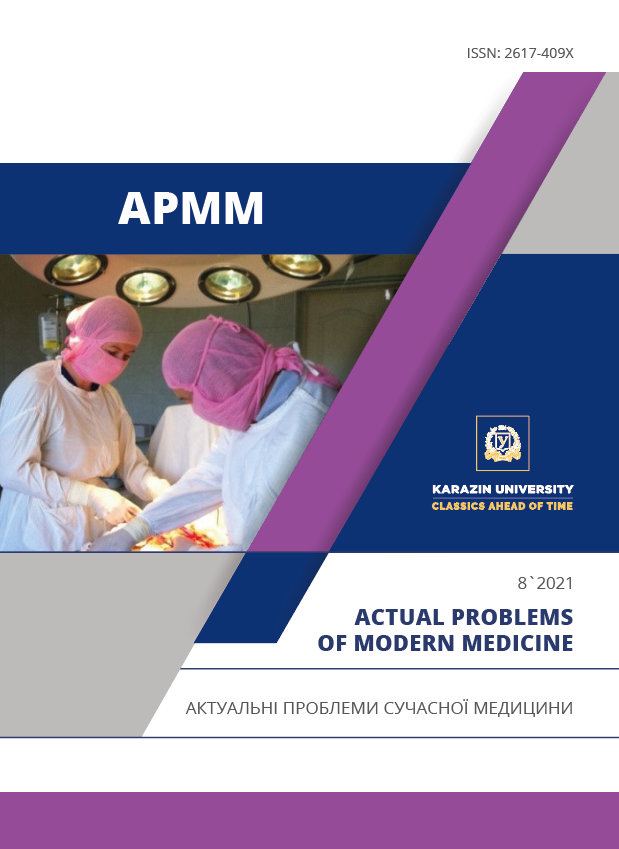Клініко-анамнестична характеристика дітей з гастроінтестинальною харчовою алергією
Анотація
Резюме. Зростає поширеність харчової алергії, особливо серед дітей. Клінічні прояви харчової алергії різноманітні, залежать від механізмів патогенезу. Існує необхідність вдосконалення діагностичного пошуку та раннього розпізнавання харчової алергії, особливо її гастроінтестинальних проявів.
Мета. Оцінити наявність, частоту і характер шлунково-кишкових проявів у дітей з харчовою алергією.
Матеріали та методи. Проаналізовано клініко-анамнестичні дані 29 дітей (12 дівчаток, 17 хлопчиків) з гастроінтестинальними проявами з підтвердженою харчовою алергією.
Результати. Найчастіше гастроінтестинальні прояви харчової алергії виявилися у дітей віком від 4 до 7 років (55,17%, 16/29). Характер скарг з боку шлунково-кишкового тракту дітей обстеженої групи здебільшого представлений епігастральним болем (62,07%, 18/29), метеоризмом (24,14%, 7/29), неоформленим стільцем з неперетравленими частинками їжі та слизом у калі (27,59%, 8/29%). Шлункова-кишкові розлади як перший прояв алергічного «маршу» спостерігався у 20,69% (6/29%) пацієнтів. В залежності від імунологічних механізмів виникнення гастроінтестинльних сиптомів у відповідь на харчові продукти IgE-опосередкована харчова алергія спостерігалася у 72,41% (21/29) обстежених дітей у вигляді негайної гастроінтестинальної гіперчутливості 65,51% (19/29) та орального алергічного синдрому 6,89% (2/29). Не-IgE-опосередкована харчова алергія представлена білок-індукованим ентероколітом та проктосигмоїдитом у 27,58% (8/29) дітей.
Висновки. Клінічна симптоматика шлунково-кишкових проявів харчової алергії у дітей залежить від імунологічних механізмів її виникнення, що потрібно враховувати під час діагностичного пошуку. Гастроінтестинальна форма харчової алергії має бути виявлена якнайшвидше для запобігання еволіції та прогресування алергічного «маршу». Тому необхідні розробка та пошук методів і маркерів своєчасної діагностики цих станів, починаючи з дітей перших місяців життя, які походять з сімей з обтяженим з алергії анамнезом.
Завантаження
Посилання
Sackesen C, Altintas DU, Bingol A, Bingol G, Buyuktiryaki B, Demir E, et al. Current Trends in Tolerance Induction in Cow’s Milk Allergy: From Passive to Proactive Strategies. Front. Pediatr. 2019;7:372. DOI: https://doi.org/10.3389/fped.2019.00372.
Lee S. IgE-mediated food allergies in children: prevalence, triggers, and management. Korean J Pediatr. 2017;60:99–105. DOI: https://doi.org/10.3345/kjp.2017.60.4.99.
Elizur A, Katz Y. Timing of allergen exposure and the development of food allergy: treating before the horse is out of the barn. Curr Opin Allergy Clin Immunol. 2016;16:157–64. DOI: https://doi.org/10.1097/ACI.0000000000000243.
Prescott SL, Pawankar R, Allen KJ, Campbell DE, Sinn JKh, Fiocchi A, et al. A global survey of changing patterns of food allergy burden in children. World Allergy Organ J. 2013;6:21. DOI: https://doi.org/10.1186/1939-4551-6-21.
Nurmatov U, Dhami S, Arasi S, Pajno GB, Fernandez-Rivas M, Muraro A, et al. Allergen immunotherapy for IgE-mediated food allergy: a systematic review and meta-analysis. Allergy. 2017;72:1133–1147. DOI: https://doi.org/10.1111/all.13124.
Nwaru BI, Hickstein L, Panesar SS, Muraro A, Werfel T, Cardona V, et al. EAACI Food Allergy and Anaphylaxis Guidelines Group. The epidemiology of food allergy in Europe: a systematic review and meta-analysis. Allergy. 2014;69:62–75. DOI: https://doi.org/10.1111/all.12305.
Dhami S, Nurmatov U, Pajno GB, Fernandez-Rivas M, Muraro A, Roberts G, et al. Allergen immunotherapy for IgE-mediated food allergy: protocol for a systematic review. Clin Transl Allergy. 2016;6:24. DOI: https://doi.org/10.1186/s13601-016-0113-z.
Gupta RS, Springston EE, Warrier MR, Smith B, Kumar R, Pongracic J, et al. The prevalence, severity, and distribution of childhood food allergy in the United States. Pediatrics. 2011;128:e9–17. DOI: https://doi.org/10.1542/peds.2011-0204.
Nocerino R, Leone L, Cosenza L, Berni Canani R. Increasing rate of hospitalizations for food-induced anaphylaxis in Italian children: an analysis of the Italian Ministry of Health database. J Allergy Clin Immunol. 2015;135:833–5. DOI: https://doi.org/10.1016/j.jaci.2014.12.1912.
Venter C, Brown T, Meyer R, Walsh J, Shah N, Nowak-Wegrzyn A, et al. Better recognition, diagnosis and management of non-IgE-mediated cow's milk allergy in infancy: iMAP-an international interpretation of the MAP (Milk Allergy in Primary Care) guideline. Clin Transl Allergy. 2017;7:26. DOI: https://doi.org/10.1186/s13601-017-0162-y.
Chernysh Yu, Okhotnikova E, Dyadyk E. Endoscopic and histological characteristics of gastrointestinal food allergy in children. Pediatrics. Eastern Europe. 2021;9(3):336-346. DOI: https://doi.org/10.34883/PI.2021.9.3.002. [in Russian]




